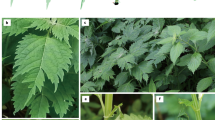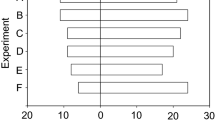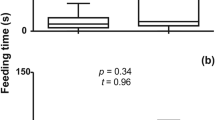Abstract
Sabotaging behavior and decision-making during ontogeny in herbivorous insects remain largely underappreciated. Insects that use hosts bearing articulated laticifers would be expected to cut trenches to deactivate this plant defense. Contrary to this expectation, larvae of Danaus erippus display vein cutting when feeding on Asclepias curassavica, a host with articulated anastomosing laticifers; the frequency of sabotaging varies according to ontogeny. Scant records indicate that larvae of the congener Danaus gilippus perform both trenching and vein-cutting on milkweeds. In view of this incongruency, we examined the sabotaging behavior of D. gilippus on A. curassavica during larval ontogeny. Continuous observations of D. gilippus on A. curassavica revealed that the larvae always sabotaged leaves before feeding. Leaves were selected by larvae of D. gilippus for size but not age. Early instars cut trenches on large leaves, and the frequency of trenching decreased as the larvae grew. Vein cutting became predominant in late instars, and petiole cutting was observed in all last instars. Because sabotaging behavior was ubiquitous, artificial trenches and cuts were made on intact leaves to examine if leaf severance affects sabotaging frequency; sabotaging decreased significantly in artificially damaged leaves. Although sabotaging behavior has a strong innate component in D. gilippus, information regarding leaf dimension and severance is important in the decision-making processes for sabotaging to take place. As D. gilippus differs from D. erippus with respect to sabotaging type and frequency when feeding on the same host, other factors than plant anatomy probably play a role in mediating sabotaging behavior in this butterfly group.




Similar content being viewed by others
References
Ackery PR, Vane-Wright RI (1984) Milkweed butterflies: their cladistics and biology. British Museum of Natural History, London
Agrawal AA, Fishbein M (2006) Plant defense syndromes. Ecology 87:132–149
Agrawal AA, Fishbein M (2008) Phylogenetic escalation and decline of plant defense strategies. PNAS 105:10057–10060
Agrawal AA, Konno K (2010) Latex: a model for understanding mechanisms, ecology and evolution of plant defence against herbivory. Annu Rev Ecol Syst 40:311–331
Altmann J (1974) Observational study of behavior: sampling methods. Behaviour 69:227–263
Beccaloni GW, Viloria AL, Hall SK, Robinson GS (2008) Catalogue of the hostplants of the neotropical butterflies, vol 8. Monografías Tercer Milenio, Saragossa
Becerra JX (2007) The impact of herbivore-plant coevolution on plant community structure. PNAS 114:7483–7488
Becerra JX, Noge K, Venable DL (2009) Macroevolutionary chemical escalation in an ancient plant-herbivore arms race. PNAS 106:18062–18066
Bernays EA, Singer MS, Rodrigues D (2004a) Foraging in nature: foraging efficiency and attentiveness in caterpillars with different diet breadths. Ecol Entomol 29:389–397
Bernays EA, Singer MS, Rodrigues D (2004b) Trenching behavior by the caterpillars of the Euphorbia specialist, Pygarctyia roseicapitis: a field study. J Insect Behav 17:41–52
Bollwinkel CW (1969) A revision of South American species of Asclepias L. PhD Dissertation, Southern Illinois University, Carbondale, Illinois
Brower AVZ, Wahlberg N, Ogawa JR, Boppré M, Vane-Wright RI (2010) Phylogenetic relationships among genera of Danainae butterflies (Lepidoptera: Nymphalidae) as implied by morphology and DNA sequences. Syst Biodivers 8:75–89
Clarke AR, Zalucki MP (2000) Foraging and vein-cutting behavior of Euploea core corinna (W.S. Macleay) (Lepidoptera: Nymphalidae) caterpillars feeding on latex-bearing leaves. Aust J Entomol 39:283–290
Compton SG (1987) Aganais speciosa and Danaus chrysippus (Lepidoptera) sabotage the latex defences of their host plants. Ecol Entomol 12:115–118
Compton SG (1989) Sabotage of latex defences by caterpillars feeding on fig trees. S Afr J Sci 85:605–606
Demarco D, Castro MM (2008) Laticíferos articulados anastomosados em espécies de Asclepiadeae (Asclepiadoideae, Apocynaceae) e suas implicações ecológicas. Rev Bras Bot 31:701–713
Dussourd DE (1990) The vein drain; or, how insects outsmart plants. Nat Hist 90:44–49
Dussourd DE (1993) Foraging with finesse: caterpillar adaptations to circumvent plant defence. In: Stamp NE, Casey TM (eds) Caterpillars: ecological and evolutionary constraints on foraging. Chapman and Hall, New York, pp 93–131
Dussourd DE (1997) Plant exudates trigger leaf-trenching by cabbage loopers, Trichoplusia ni (Noctuidae). Oecologia 112:362–369
Dussourd DE (1999) Behavioral sabotage of plant defense: do vein cuts or trenches reduce exposure to plant exudates? J Insect Behav 12:501–515
Dussourd DE (2009) Do canal-cutting behaviours facilitate host-range expansion by insect-herbivores? Biol J Linn Soc 96:715–731
Dussourd DE, Denno RF (1991) Deactivation of latex defense: correspondence between insect behavior and secretory canal architecture. Ecology 72:1383–1396
Dussourd DE, Denno RF (1994) Host range of generalist caterpillars: trenching permits feeding on plants with secretory canals. Ecology 75:69–78
Dussourd DE, Eisner T (1987) Vein-cutting behavior: insect counterploy to the latex defense of plants. Science 237:898–901
Ehrlich PR, Raven PH (1964) Butterflies and plants: a study in coevolution. Evolution 18:586–608
Helmus MR, Dussourd DE (2005) Glues or poisons: which triggers vein cutting by monarch caterpillars? Chemoecology 15:45–49
Mitter C, Farrel B, Futuyma DJ (1991) Phylogenetic studies of insect-plant interactions: insights into the genesis of diversity. TREE 6:290–293
Pliske TE, Eisner T (1969) Sex pheromone of the queen butterfly: biology. Science 164:1170–1172
Rodrigues D, Maia PHS, Trigo JR (2010) Sabotaging behavior and minimal latex of Asclepias curassavica incur no cost for larvae of the southern monarch butterfly Danaus erippus. Ecol Entomol 35:504–513
Thompson JN (1989) Concepts of coevolution. TREE 4:179–183
Vermeij GJ (1994) The evolutionary interactions among species: selection, escalation and coevolution. Annu Rev Ecol Syst 25:219–236
Waldbauer GP (1968) The consumption and utilization of food by insects. Adv Insect Physiol 5:229–288
Wilson KJ, Mahlberg PG (1980) Ultrastructure of developing and mature nonarticulated laticifers in the milkweed Asclepias syriaca L. (Asclepiadaceae). Am J Bot 67:1160–1170
Zalucki MP, Malcolm SB (1999) Plant latex and first-instar monarch larval growth and survival on three North American milkweed species. J Chem Ecol 25:1827–1842
Zalucki MP, Brower LP, Alonso-M A (2001a) Detrimental effects of latex and cardiac glycosides on survival and growth of first-instar monarch butterfly larvae Danaus plexippus feeding on the sandhill milkweed Asclepias humistrata. Ecol Entomol 26:212–224
Zalucki MP, Malcolm SB, Paine TD, Hanlon CC, Brower LP, Clarke AR (2001b) It’s the first bites that count: survival of the first-instar monarchs on milkweeds. Austral Ecol 26:547–555
Zalucki MP, Malcolm SB, Hanlon CC, Paine TD (2012) First-instar monarch larval growth and survival on milkweeds in southern California: effects of latex, leaf hairs, and cardenolides. Chemoecology 22:75–88
Acknowledgments
We are grateful to Jorge Bizarro, Raquel Locke and Nicolas Locke for allowing us to collect insects at the Reserva Ecológica de Guapiaçu (REGUA). José R. Trigo helped us with collecting insects and plants, and Marina Oliveira provided laboratory assistance. Carmen Odete Antinarelli and the staff of the Horto da Prefeitura Universitária, as well as Ricardo Monteiro, Margarete Macedo and members of the Laboratório de Ecologia de Insetos / UFRJ provided suitable space for rearing larvae and performing the experiments. Bruna Ramos exchanged some ideas on data presentation. David Dussourd, Diogo Loretto, José R. Trigo, Janet Read and three anonymous reviewers kindly read previous drafts of the manuscript. Above all, we are indebted to Vinicius Farjalla, as this study could not have been conducted without his help. PPSF received a senior student grant from the Universidade Federal do Rio de Janeiro (PIBIC/UFRJ); DR acknowledges grants from the Conselho Nacional de Pesquisa/CNPq (480.264/2010-4) and the Fundação de Apoio à Pesquisa do Estado do Rio de Janeiro/FAPERJ (110.726/2013).
Author information
Authors and Affiliations
Corresponding author
Rights and permissions
About this article
Cite this article
Ferreira, P.P.S., Rodrigues, D. Sabotaging Behavior and Decision-Making in Larvae of the Queen Butterfly Danaus gilippus . J Insect Behav 28, 460–472 (2015). https://doi.org/10.1007/s10905-015-9514-4
Revised:
Accepted:
Published:
Issue Date:
DOI: https://doi.org/10.1007/s10905-015-9514-4




